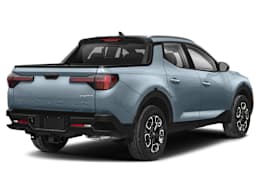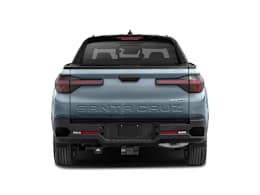The Santa Cruz combines the attributes of a small SUV and a pickup truck into one vehicle. Similar in concept to the larger Honda Ridgeline, the Tucson-based Santa Cruz could be perfect for the buyer who wants a stylish mode of transport with car-like ride, handling, and maneuverability but who also occasionally needs an open bed to avoid getting their SUV’s cargo area dirty.
At just over four-feet long, the Santa Cruz’s bed is smaller than that of any other pickup, including the Ford Maverick and Ridgeline. As such, it isn’t well suited to carrying bicycles or any number of common recreational toys. But the Santa Cruz—which Hyundai markets as a “Sport Adventure Vehicle”—is perfect for transporting grubby garden supplies, grills and coolers for tailgating, or carrying wet gear back from the lake when towing a small boat.
With 281 horsepower on tap, the optional 2.5-liter turbocharged four-cylinder makes the Santa Cruz SEL Premium we tested feel zippy, with especially strong low-to-midrange grunt. It sprinted from 0 to 60 mph in a pretty quick 6.6 seconds. There is some occasional low-speed clunkiness from the eight-speed dual-clutch automatic transmission, but shifts are smooth and timely. It managed 24 mpg overall on regular fuel in our testing, which is significantly better than the 20 mpg overall the Ranger and Ridgeline achieve. The base engine is a rather strained 191-hp, 2.5-liter four-cylinder mated to a conventional eight-speed automatic transmission. The SE and SEL are available with either front- or all-wheel drive, while the SEL Premium and Limited come with the turbo engine combined with all-wheel drive.
Not surprising given the Hyundai’s size, its handling feels responsive and athletic through turns, in spite of steering that’s a little too light for our tastes. It holds its line through corners nicely and, unlike traditional pickups, the rear end of the Santa Cruz doesn’t get unsettled by mid-corner bumps. The firm, refined ride is more akin to that of a good SUV than a typical pickup. The suspension absorbs most bumps well, even soaking up larger potholes nicely. It’s also pretty easy to maneuver, especially in comparison to larger compact- or full-sized pickups, the latter a real bear to park in tight lots, garages, or on city streets.
The front seats are fairly basic but comfortable and supportive, the driver’s seat aided by two-way lumbar adjustment. The driving position is slightly elevated, giving a decent forward view, yet there’s still plenty of headroom. Most drivers found that the plastic center console intruded upon their right-knee space. The rear seat has decent headroom, but the seatback is very upright, which compromises comfort. Rear visibility is hampered by short second-row windows, thick rear pillars, and a relatively small rear window.
The cabin has quality materials, stylish controls, and more padded surfaces than most pickups. The eight-inch infotainment touch screen is easy to use, with large, simple-to-decipher icons, and it features standard wireless Android Auto and Apple CarPlay. We also appreciated the conventional, easy-to-operate gear selector.
In terms of truck duty, the Santa Cruz—when fitted with the optional turbocharged engine and all-wheel drive—can pull a trailer of up to 5,000 pounds, a capacity more often associated with larger vehicles. It also has a very respectable 1,400-pound payload rating. The composite bed has a small, concealed pseudo trunk, and the built-in hard, rollable tonneau cover that comes on higher trims is handy for keeping cargo safe, although the setup eats up nearly a foot of space at the upper/front portion of the already-short bed.
Forward collision warning, automatic emergency braking with pedestrian and cyclist detection, lane departure warning, and lane keeping assistance come standard. For 2023, blind spot warning and rear cross traffic warning with rear automatic braking come standard. Buyers will have to spring for the SEL Premium if they want adaptive cruise control.


























